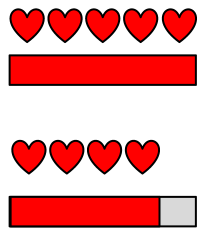Health Bars (D&D) are NOT Engaging, Let's Fix Them
Promoting teamwork and rewarding healing, supporting, and defending by reworking health bars.
Your Health Decreases, Whoop-de-doo
At its simplest a health bar is a clock, and when the clock strikes 12 you can’t play your character anymore. Sometimes another character or even your own character (with a healing potion) can turn back this clock and now you can play your character for longer… until you can’t.
1. I Love Combat
The feeling of absolutely demolishing an enemy’s health bars is sublime! But your own health bar being drained, I’m yawning. This is fully realized in Dungeons and Dragons (D&D) 5e’s health system and made insufferable by its death system.
2. D&D 5e’s Death System - Motivation to Design My Own System
For those unfamiliar D&D 5e’s death system uses death saving throws to signal the potential end and bring about a player character’s (PC) death. If a player does not have health points left their turn is rolling a d20 without modifiers (“You’re in the hands of fate now.”) for a 55% chance of succeeding: needing 3 successes to stabilize, and if you are so unlucky as to roll 3 failures your character dies.
Several 5e problems I plan to solve in Vices of Valor:
PCs effectively lose multiple turns, especially if no healing is available.
PCs can’t defend/act in their final moments.
Healing will bring you right back into the action.
3. Healing - A Problem?
But Wijs, don’t you love healing and supports in TTRPGs? Yes, but in 5e because there is no penalty to taking extra damage beyond going to zero… (besides a few exceptions) the best strategy for healing is to wait until your fellow PCs have entered the downed state before you heal them. This way you keep your friends alive and in the action economy for as long as possible; because healing them 5 health before they were downed wouldn’t have made a difference - they still would have gone down last turn.
Vices of Valor
One of my core goals in making Vices of Valor, my own tabletop role playing game (TTRPG), is to “make health bars more engaging, therefore promoting and rewarding more proactive healing/supporting/defending.” So, let’s do that!
A few things to note as you read these snippets of the Vices of Valor system: Vigor is effectively energy; Resolve is effectively health - it is composed of two “health bars” Trauma and Scars; Trauma can be healed with magic and triage, Scars cannot.
Health & Death:
Resolve – Creatures gain 1 Scar tolerance per Resolve.
Trauma – Damage taken is applied as Trauma first. Trauma tolerance is equal to available Scar tolerance.
Scars – Damage taken is applied as Scars if the creature's Trauma tolerance is at max.
Desperate – When a creature has Scars equal to or more than half their Resolve (rounded up).
Death – When a creature has reached its max Scar tolerance, they are Dead. Creatures can through rare circumstances be revived back to life, often with drawbacks.
Barrier – Expend to negate 1 incoming effect.
Armor – Expend to negate 1 incoming attack.
Downtime - Recovering Health:
A state where the adventuring team recover from their encounters and prepare for whatever is next. Most downtime is solved through a mix of roleplay and some dice.
Meal – About 2 hours where the team spends time recovering. Can only be done twice in between Sleep.
Clear all fatigue (vigor).
Gain boosts from consumed food, drink and company kept.
Sleep – About 1 day where the team spends time recovering after setting up camp.
Clear all fatigue and exhaustion (vigor).
Clear all trauma (resolve).
Gain boosts from consumed food, drink and company kept.
Engage in 1 pastime activity.
Sanctuary – About 7 days spent at a safe location where downtime activities cannot be interrupted.
Clear all fatigue and exhaustion (vigor).
Clear all trauma and scars (resolve).
Gain boosts from consumed food, drink and company kept.
Engage in 10 pastime activities, activities can be repeated.
What’s the Intent? TLDR
Trauma is healable through PC’s intervention. So, by giving Resolve two health bars, Trauma and Scars, and making Scars cause the max tolerance of Trauma to be equal to the available Scar tolerance - it promotes proactive healing, supporting, and defending so that scars are avoided if possible. Helping realizes the trinity of healer/support, defender/tank, and attacker playstyle fantasies all feel rewarding to play.
While I don’t go over it in this blog post, becoming “Desperate” gives PCs survivability as they get closer to death’s door - allowing them to defend and act appropriately as the encounter’s tension rises. No turns are lost due to being at death’s door, you still get to act and make decisions!
Sanctuary downtime at a safe location being the only way to address Scars reinforces that Scars are to be proactively avoided if at all possible. Making acquired scars impactful and weigh heavily on a player’s mind; and rewarding when the team pulls through an encounter with minimal scars.





Great read, Wijs! I really like the direction you're taking with making health more engaging. Have you checked out how Daggerheart handles death and recovery? It’s got some interesting ideas that might spark something for Vices of Valor.
Very well done. Easily one of the better blogs i have read. Definetly going to be following for more info